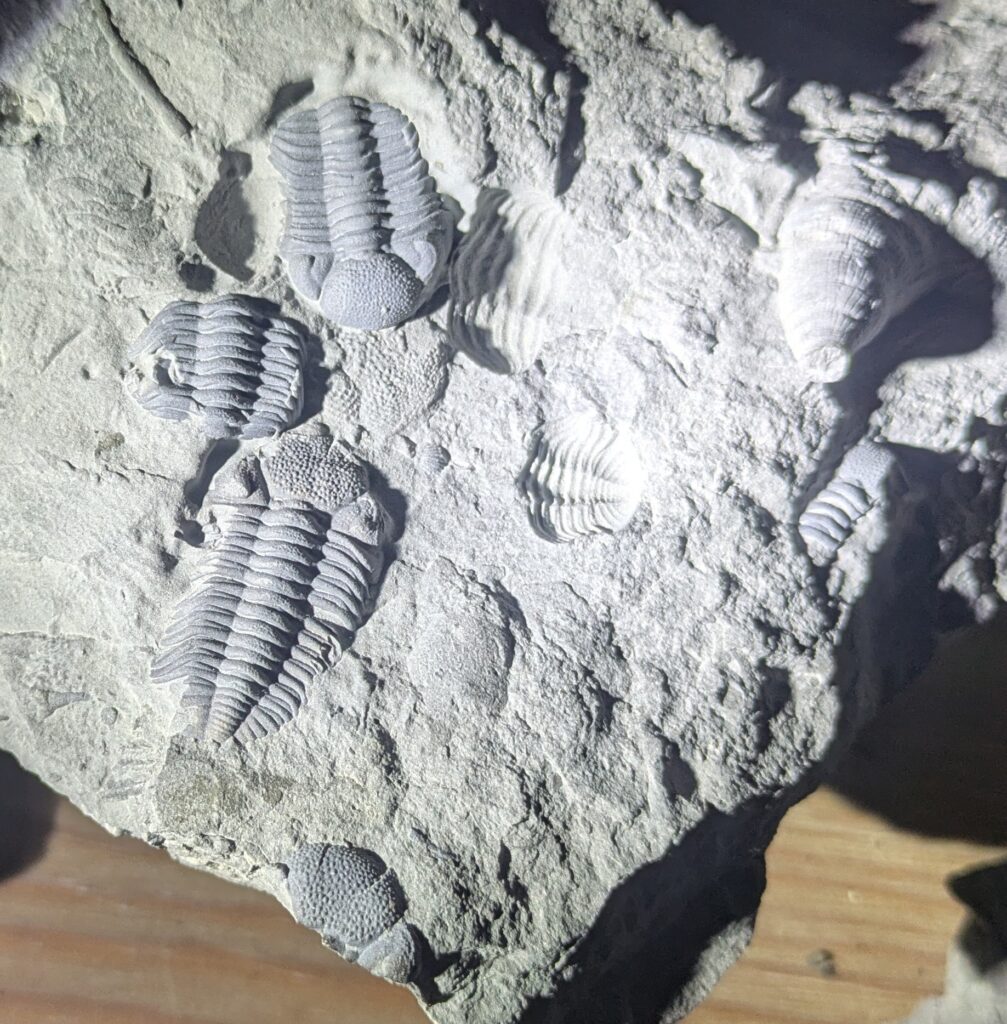Trilobites are one of the most iconic and diverse groups of extinct marine arthropods, thriving for over 270 million years from the Cambrian Period (521 million years ago) to the end of the Permian (252 million years ago). Their fossil record provides unparalleled insights into the evolution of life on Earth, showcasing rapid diversification, adaptability, and eventual extinction.
Origins of Trilobites: Early Evolution
Trilobites first appeared during the Cambrian Explosion, a period of rapid evolutionary innovation. Emerging around 521 million years ago, they were among the earliest arthropods to develop hard exoskeletons, a feature that greatly enhanced their fossilization potential.
- Early Features:
- Trilobites were segmented, with a three-lobed body plan (hence the name “trilobite”), divided into the cephalon (head), thorax (middle), and pygidium (tail).
- Their calcified exoskeletons provided protection and structural support.
- Compound eyes, among the most advanced of their time, gave them a significant advantage in detecting predators and prey.
- Cambrian Diversification:
- Trilobites rapidly diversified into numerous ecological niches, becoming dominant marine organisms. Early genera, such as Olenellus and Redlichia, displayed adaptations for burrowing, swimming, or scavenging.
Diversification Across Geological Periods
Trilobites experienced significant evolutionary radiation throughout their history, driven by changing environments, competition, and predation pressures.
Cambrian Period: The First Explosion of Trilobite Diversity
- Trilobites were the dominant arthropods in Cambrian seas, with over 20 families emerging.
- Early forms, like Paradoxides and Agnostus, displayed a wide range of morphologies, reflecting adaptations to various ecological roles.
- They played key roles in Cambrian ecosystems as predators, scavengers, and detritivores.
Ordovician Period: A Golden Age
- Trilobites reached their peak diversity during the Ordovician (485–443 million years ago), coinciding with the Great Ordovician Biodiversification Event.
- Genera like Calymene and Flexicalymene were abundant, while some species developed spines and other defensive adaptations in response to the rise of marine predators.
- Trilobites diversified into deep-sea habitats, shallow reefs, and benthic (seafloor) environments.
Silurian and Devonian Periods: Decline and Specialization
- As marine ecosystems evolved, trilobites began to decline in diversity but exhibited fascinating adaptations.
- Some, like Phacops, developed highly specialized compound eyes, possibly for better vision in dimly lit environments.
- Reef-associated trilobites, such as Deiphon, evolved ornate spines and ridges, perhaps for camouflage or protection.
- Trilobites faced increasing competition from jawed fish, mollusks, and other arthropods, pushing them into more specialized niches.
Carboniferous and Permian Periods: The Final Chapters
- Trilobite diversity dwindled significantly during the Carboniferous (359–299 million years ago) as marine ecosystems continued to evolve.
- By the Permian (299–252 million years ago), only a few specialized trilobite families, like Proetidae, remained.
- The Permian-Triassic Mass Extinction, the largest extinction event in Earth’s history, marked the end of trilobites, along with over 90% of marine species.
Evolutionary Innovations
Trilobites were pioneers in many evolutionary aspects:
- Exoskeletons:
- Their calcified exoskeletons provided defense and support, making trilobites highly adaptable to different environments.
- Eyes:
- Trilobites had compound eyes made of calcite, a unique feature among arthropods, allowing them exceptional vision in marine settings.
- Molting:
- Trilobites shed their exoskeletons as they grew, leaving behind abundant fossil evidence.
- Enrollment:
- Many trilobites could roll into a ball, much like modern pill bugs, as a defense mechanism against predators.
Fossil Record and Legacy
Trilobites left an extraordinary fossil record, with over 20,000 described species. Their widespread distribution and rapid evolution make them crucial index fossils for dating Paleozoic rock formations.
- Famous Fossil Sites:
- Burgess Shale (Canada): Preserves soft-bodied trilobites alongside other Cambrian fauna.
- Jince Formation (Czech Republic): Known for its diverse Cambrian trilobite fossils.
- Wales and Morocco: Rich in Ordovician and Devonian trilobites, including spectacularly preserved specimens.
Extinction and Enduring Fascination
The extinction of trilobites at the end of the Permian marked the end of a remarkable evolutionary lineage. However, their legacy endures:
- Scientific Importance:
- Trilobites provide a detailed record of marine life across nearly 300 million years, shedding light on evolutionary trends and extinction dynamics.
- Cultural Impact:
- Their intricate fossils captivate collectors and scientists alike, symbolizing Earth’s deep history and the wonder of paleontology.
Trilobites remain an enduring symbol of the Paleozoic Era, showcasing the evolutionary potential of life and the intricate interplay between organisms and their environments. Their story is one of triumph, adaptation, and eventual decline—a testament to the dynamic history of life on Earth.


